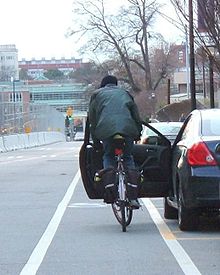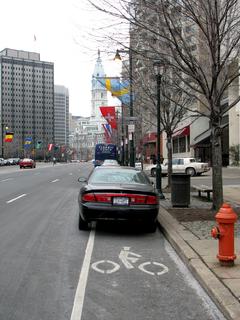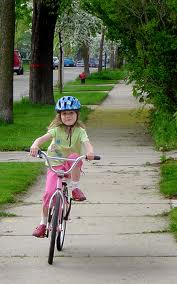
A SUMMARY OF NY STATE BIKE LAWS
As a veteran bicycle crash lawyers, Daniel Flanzig and Jim Reed decided it was time to summarize our state laws so everyone sharing the road knows their rights. This is a compliations of laws in New York State and New York City that apply to both cyclists and motorists.
Why these Laws Apply to Cyclists
NY Vehicle and Traffic Law (VTL) – §1231 – Traffic laws apply to persons riding bicycles – Every person riding a bicycle ….. upon a roadway shall be granted all of the rights and shall be subject to all of the duties applicable to the driver of a vehicle.
Rules of the City of N.Y. (RCNY) 4-02 (a) – The provisions of N.Y.C. Traffic Rules are applicable to bicycles and their operators.
Safe Passing Law: Motor Vehicles Passing Bikes
 VTL 1146 – Drivers to exercise due care. (a) Notwithstanding the provisions of any other law to the contrary, every driver of a vehicle shall exercise due care to avoid colliding with any bicyclist, pedestrian, or domestic animal upon any roadway and shall give warning by sounding the horn when necessary. For the purposes of this section, the term “domestic animal” shall mean domesticated sheep, cattle, and goats which are under the supervision and control of a pedestrian.
VTL 1146 – Drivers to exercise due care. (a) Notwithstanding the provisions of any other law to the contrary, every driver of a vehicle shall exercise due care to avoid colliding with any bicyclist, pedestrian, or domestic animal upon any roadway and shall give warning by sounding the horn when necessary. For the purposes of this section, the term “domestic animal” shall mean domesticated sheep, cattle, and goats which are under the supervision and control of a pedestrian.
VTL 1122 – The operator of a vehicle overtaking, from behind, a bicycle proceeding on the same side of a roadway shall pass to the left of such bicycle at a safe distance until safely clear thereof.
VTL 1120 – All motorists must drive on the right side of a roadway, except in the following situations:
• When passing another vehicle traveling in the same direction;
• When passing a cyclist, pedestrian, animals, or obstructions in the roadway.
RCNY 19-190 – Right of Way –
Subdivision (a) provides that if a motor vehicle driver fails to yield to a pedestrian or bicyclist who has the right of way, the driver shall be subject to a civil penalty of not more than $100, in addition to or as an alternative to the penalties that can be imposed for committing a traffic infraction as provided in the law. Subdivision (b) of Section 19-190 provides that if a driver violates subdivision (a) and the vehicle causes contact with the pedestrian or bicyclist, and thereby causes physical injury, the driver shall be subject to a civil penalty of not more than $250, in addition to or as an alternative to the penalties that can be imposed for committing a misdemeanor as provided in the law.
Bikes Passing on the Right
VTL 1123 – Overtaking on the right – The driver of a vehicle may overtake and pass upon the right of another vehicle only under the following conditions:
• When the vehicle overtaken is making or about to make a left turn;
• Upon a street or highway with unobstructed pavement not occupied by parked vehicles of sufficient width for two or more lines of moving vehicles in each direction;
• Upon a one-way street, or upon any roadway on which traffic is restricted to one direction of movement, where the roadway is free from obstructions and of sufficient width for two or more lines of moving vehicles.
• (b) The driver of a vehicle may overtake and pass another vehicle upon the right only under conditions permitting such movement in safety. Such movement shall not be made by driving off the pavement or main-traveled portion of the roadway, except as permitted by section eleven hundred thirty-one of this article.
“Doorings”
 VTL 1214 – Opening and closing vehicle doors – “No person shall open the door of a motor vehicle on the side available to moving traffic, and until it is reasonably safe to do so and can be done without interfering with the movement of other traffic, nor shall a person leave a door open on the side of a vehicle available to moving traffic for a period of time longer than necessary to load or unload passengers.”
VTL 1214 – Opening and closing vehicle doors – “No person shall open the door of a motor vehicle on the side available to moving traffic, and until it is reasonably safe to do so and can be done without interfering with the movement of other traffic, nor shall a person leave a door open on the side of a vehicle available to moving traffic for a period of time longer than necessary to load or unload passengers.”
RCNY 4-12-(c) – Getting Out of a Vehicle – “No person shall get out of any vehicle from the side facing on the traveled part of the street in such manner as to interfere with the right of the operator of an approaching vehicle or a bicycle.”
“Doored” by a NYC Cab
RCNY 4-11(c) – “Taxis….while engaged in picking up or discharging passengers must be within 12 inches of the curb or parallel thereto “.
RCNY 4-11 (c) -Taxi and Cars for Hire – Picking up or discharging passengers shall not be made under such conditions as to obstruct the movement of traffic and in no instance so as to leave fewer than 10 feet available for the free movement of vehicular traffic; where stopping is prohibited; or within a bicycle lane.
Bike Lanes and Road Position for Cyclists
 VTL 102-a – Definition of Bicycle Lane – A portion of the roadway which has been designated by striping, signing and pavement markings for the preferential or exclusive use of bicycles.
VTL 102-a – Definition of Bicycle Lane – A portion of the roadway which has been designated by striping, signing and pavement markings for the preferential or exclusive use of bicycles.
VTL 1234. Riding on roadways, shoulders, bicycle or in-line skate lanes and bicycle or in-line skate paths. (a) Upon all roadways, any bicycle or in-line skate shall be driven either on a usable bicycle or in-line skate lane or, if a usable bicycle or in-line skate lane has not been provided, near the right-hand curb or edge of the roadway or upon a usable right-hand shoulder in such a manner as to prevent undue interference with the flow of traffic except when preparing for a left turn or when reasonably necessary to avoid conditions that would make it unsafe to continue along near the right-hand curb or edge.
Conditions to be taken into consideration include, but are not limited to, fixed or moving objects, vehicles, bicycles, in-line skates, pedestrians, animals, surface hazards or traffic lanes too narrow for a bicycle or person on in-line skates and a vehicle to travel safely side-by-side within the lane.
**VTL § 1234 Does Not apply in New York City. It is specifically superseded by 34 RCNY 4-02 (e) **
RCNY 4-12 (p)(1) Bicyclists may ride on either side of one-way roadways that are at least 40 feet wide.
RCNY 4-12 (p)(3) Bicyclists should ride in usable bike lanes, unless they are blocked or unsafe for any reason.
RCNY 4-12 (o) Bicycles are prohibited on expressways, drives, highways, interstate routes, bridges, and thruways unless authorized by signs.
Riding Single File or No More than 2 Abreast
VTL 1234 (b) Persons riding bicycles or skating or gliding on in-line skates upon a roadway shall not ride more than two abreast. Persons riding bicycles or skating or gliding on in-line skates upon a shoulder, bicycle or in-line skate lane, or bicycle or in-line skates path, intended for the use of bicycles or in-line skates may ride two or more abreast if sufficient space is available, except that when passing a vehicle, bicycle or person on in-line skates, or pedestrian, standing or proceeding along such shoulder, lane or path, persons riding bicycles or skating or gliding on in-line skates shall ride, skate, or glide single file. Persons riding bicycles or skating or gliding on in-line skates upon a roadway shall ride, skate, or glide single file when being overtaken by a vehicle.
Stop Before Entering Roadway
VTL 1234 (c) Any person operating a bicycle or skating or gliding on in-line skates who is entering the roadway from a private road, driveway, alley or over a curb shall come to a full stop before entering the roadway.
Cars Blocking or Obstructing Bike Lanes in NYC
 RCNY Section 4-08(e) – Block or obstructing a Bike lane – “No Stopping Zones (Stopping, standing, and parking prohibited in specified places). No person shall stop, stand, or park a vehicle in any bicycle lanes or within a designated bicycle lane….”
RCNY Section 4-08(e) – Block or obstructing a Bike lane – “No Stopping Zones (Stopping, standing, and parking prohibited in specified places). No person shall stop, stand, or park a vehicle in any bicycle lanes or within a designated bicycle lane….”
RCNY 4-12(p)(2) – No person shall drive a vehicle on or across a designated bicycle lane, except when it is reasonable and necessary:
(i) to enter or leave a driveway; or
(ii) (ii) to enter or leave a legal curbside parking space; or
(iii) (iii) to cross an intersection; or
(iv) (iv) to make a turn within an intersection; or
(v) (v) to comply with the direction of any law enforcement officer or other person authorized to enforce this rule; or
(vi) (vi) to avoid an obstacle which leaves fewer than ten feet available for the free movement of vehicular traffic.
(vii) Notwithstanding any other rule, no person shall drive a vehicle on or across a designated bicycle lane in such manner as to interfere with the safety and passage of persons operating bicycles thereon.
Equipment
VTL 1236. Lamps and other equipment on bicycles. (a) Every bicycle when in use during the period from one-half hour after sunset to one-half hour before sunrise shall be equipped with a lamp on the front which shall emit a white light visible during hours of darkness from a distance of at least five hundred feet to the front and with a red or amber light visible to the rear for three hundred feet. Effective July first, nineteen hundred seventy-six, at least one of these lights shall be visible for two hundred feet from each side.
(b) No person shall operate a bicycle unless it is equipped with a bell or other device capable of giving a signal audible for a distance of at least one hundred feet, except that a bicycle shall not be equipped with nor shall any person use upon a bicycle any siren or whistle.
No Brakeless “Fixies” in NY
VTL 1236 (c) Every bicycle shall be equipped with a brake which will enable the operator to make the braked wheels skid on dry, level, clean pavement.
VTL 1236 (d) Every new bicycle shall be equipped with reflective tires or, alternately, a reflex reflector mounted on the spokes of each wheel, said tires and reflectors to be of types approved by the commissioner. The reflex reflector mounted on the front wheel shall be colorless or amber, and the reflex reflector mounted on the rear wheel shall be colorless or red.
VTL 1236 (e) Every bicycle when in use during the period from one-half hour after sunset to one-half hour before sunrise shall be equipped with reflective devices or material meeting the standards established by rules and regulations promulgated by the commissioner; provided, however, that such standards shall not be inconsistent with or otherwise conflict with the requirements of subdivisions (a) and (d) of this section.
2 Earphones Are Unlawful
VTL 375 24-a – Use of earphones while driving or riding a bicycle – It shall be unlawful to operate upon any public highway in this state a motor vehicle, limited use automobile, limited use motorcycle or bicycle while the operator is wearing more than one earphone attached to a radio, tape player or other audio device.
Hands on the handle bars
VTL 235 – Carrying articles – No person operating a bicycle shall carry any package, bundle, or article which prevents the driver from keeping at least one hand upon the handle bars. No person skating or gliding on in-line skates shall carry any package, bundle, or article which obstructs his or her vision in any direction. No person operating a skate board shall carry any package, bundle, or article which obstructs his or her vision in any direction.
RCNY 4-12 (e) – Cyclists must have at least one hand on handlebars at all times.
Seats and Pedals
VTL § 1232 Cyclists must ride on a permanent seat, feet must be on pedals, and bike must carry only the number of persons for which it is designed and equipped.
Children on Bikes
 VTL 1238 – Helmets and carrying children
VTL 1238 – Helmets and carrying children
• A child under age one is not permitted to ride on a bicycle.
• A child one or more years of age but less than five years of age must wear an approved helmet and be carried in a properly affixed child carrier.
• A child five or more years of age but less than fourteen years of age must wear an approved helmet.
Riding on the Sidewalk and in Parks in NYC
Admin Code – 19-176 – Bicycles ridden on sidewalks may be confiscated and riders may be subject to legal sanctions (see also: RCNY § 4-07(c) (3)
RCNY 4-07 (c) (3) No driving bikes on sidewalks, unless sign allows or wheels are less than 26 inches in diameter and rider is twelve years or younger
RCNY 4-14 (c) No person shall ride a bicycle in any park, except in places designated for bike riding; but persons may push bikes in single file to and from such places, except on beaches and boardwalks.
Riding on the Sidewalk in Other Municipalities
 The NY Vehicle and Traffic Law does not expressly regulate sidewalk bicycling. However, NY General Municipal Law (Section 180)6 states that NY municipalities can regulate bike riding on sidewalks. They cannot require that bicyclists use a sidewalk instead of a public roadway, but they can impose limits to sidewalk bicycling. So it is up to individual municipalities to regulate sidewalk cycling as they see fit.
The NY Vehicle and Traffic Law does not expressly regulate sidewalk bicycling. However, NY General Municipal Law (Section 180)6 states that NY municipalities can regulate bike riding on sidewalks. They cannot require that bicyclists use a sidewalk instead of a public roadway, but they can impose limits to sidewalk bicycling. So it is up to individual municipalities to regulate sidewalk cycling as they see fit.
Some municipalities have no sidewalk cycling regulations, while others do regulate sidewalk bicycling. For instance, the City of Elmira prohibits sidewalk cycling for persons 14 or older. The City of Ithaca prohibits cycling on the sidewalk for anyone older than 10 years old unless a person over 10 has a disability requiring the use of a bicycle as a means of transportation or mobility.
Jim Reed and Daniel Flanzig collaborated to write this compilation of laws as part of their roles as Legal Advisers/Board Members to the New York Bicycling Coalition and as bicycle collision lawyers with BikeLaw.com and NewYorkBikeLawyers.com
DISCLAIMER: Please appreciate that this compilation of cycling laws is for informational purposes only and does not constitute legal advice. Also appreciate that laws change on virtually a daily basis and accordingly whenever researching any legal issue, it is critically important to perform up-to-date research to determine the current state of the law.
If you have any legal question pertaining to cycling laws in the state of New York, please feel free to contact Jim Reed at jreed@zifflaw.com or Daniel Flanzig at dflanzig@flanziglaw.com.
Enjoy your bike and ride safely!
